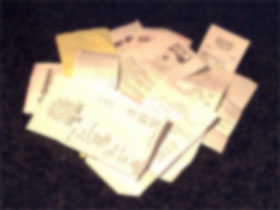Ideas To Eliminate And Automate Retail Receipts
 Although I don’t want to come off as repeating myself, paper retail receipts are out of hand. Where such receipts are important and necessary in documenting financial transactions, they can also become a cumbersome mess that can easily get out of control. Now some of you reading this may think I am going to an extreme, and you may not even save and reconcile to receipts. But I always have personally, and I have to for my Web consulting business, as any business owner should.
Although I don’t want to come off as repeating myself, paper retail receipts are out of hand. Where such receipts are important and necessary in documenting financial transactions, they can also become a cumbersome mess that can easily get out of control. Now some of you reading this may think I am going to an extreme, and you may not even save and reconcile to receipts. But I always have personally, and I have to for my Web consulting business, as any business owner should.
Here are a few more ideas I have regarding receipts, which build upon my initial rant conversation on retail receipts. As I don’t have the time, money or energy to act on these right now, I put these out there for anyone to take a stab at. Even if someone is successful and becomes a billionaire with some of them, it will eventually make my life easier!
Receipt File Format Standard – Call it the vCard or iCal standard for retail receipts. This would me an XML file structure for storing all of the data of a receipt into a file. This file will be in lieu of a paper receipt, and identifiable to the retailer by a unique serial number… which most receipts have today anyway. For the sake of discussion here, let’s call it vReceipt.
Deliver vReceipt files by SMS, Email or Web – Once a retailer creates a vReceipt, it needs to get to the customer. It could be delivered to them by any number of methods. If a customer provides their mobile number, it could be sent by SMS. If they provide their email, it could come in a message. The retailer could create a custom QR code for the transaction, and upon the customer scanning it, they could download the vReceipt from the Web. If the customer has a “membership” account with the retailer, the receipt could be delivered via their Web site.
Retailer transmits vReceipt data to third-party service via app – Why not have an app for that? When you check out, your app can show a QR code which can be scanned, then the retailer would transfer the receipt to the 3rd-party service. This service could be Quicken or your bank or a new service you use to track expenses.
Processing vReceipts Makes Expense Tracking Easy – Even though services like QuickBooks Online already sync with your bank, vReceipts can break down the transaction onto its pieces. Were 7 items purchased for work, one was a gift and the rest for the house? A vReceipt will know what was purchased, and will pre-populate the category of an item, or accept whatever override you have for it.
vReceipts App Can Be Used for Returns, Exchanges and Taxes – vReceipts should not just be for figuring out how much you spent on Pringles last year. As a replacement for paper, they should carry all the weight and responsibility of their soon-to-be-defunct paper counterparts. The identifiable information from the retailer should suffice for returns, exchanges, as well as proof for expenses for tax purposes. They would ideally replace having to fax receipts to your employer after you submit your expense report online as well.
What do you think of my ideas around vReceipts? Feel free to compliment, tear apart of use for your own, and your comments are welcome here, which along with vReceipts won’t consume any paper.
This is from The Hot Iron, a journal on business and technology by Mike Maddaloni.
Did you enjoy this? Subscribe to The Hot Iron by RSS/XML feed or Read by Email.
Business • QR Codes • Strategize • Technology • Web Development • (6) Comments • Permalink



